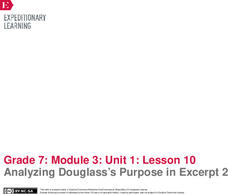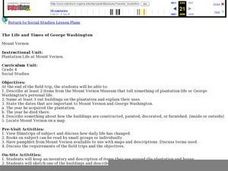Curated OER
Slavery: Acts of Resistance
Historical accounts of various events have proven to differ depending on the point of view of the person documenting the event. Learners read and analyze two first person accounts of acts of slave resistance seen at a southern...
Crafting Freedom
Harriet Jabocs and Elizabeth Keckly: The Material and Emotional Realities of Childhood in Slavery
Through the journals written by Harriet Jacobs and Elizabeth Keckly, young readers gain insight into the lives of two enslaved children on nineteenth-century plantations.
Curated OER
Meet Hannah the Weaver
Students analyze primary and secondary sources to explore slavery and emancipation, and write letter or diary entry from point of view of slave Hannah Harris or plantation owner Robert Carter. Students then dramatize their creative...
Curated OER
Gender, Sex, and Slavery
While examining slavery's impact on women, historians compare and contrast the perspectives of a plantation mistress and an enslaved woman, both reflecting on the system of forced prostitution. Text analysis and written responses create...
Scholastic
Voyage on the Mayflower for Grades 6–8
Imagine living in the hold of a sailing ship for 63 days, enduring rough seas and autumn storms. As part of a study of the voyage of the Mayflower, class members examine an online resource that details life about the ship, watch a slide...
Scholastic
Pilgrim and Wampanoag Daily Life for Grades 6–8
Two slide shows, viewed side-by-side, permit middle schoolers to compare and contrast the lives of the Pilgrims of the Plimoth colony and the Wampanoags. Four videos take learners on virtual field trips to the Plymouth plantation. And an...
Curated OER
Africa: The Middle Passage and 19th Century America
Students participate in a series of activities to explore the lives of slaves in 19th century America. They examine the design of slave ships, the hardships endured, and the ways that owners depended on slaves for their economic survival.
EngageNY
Grade 9 ELA Module 4, Unit 1, Lesson 6
How do writers create a specific tone in their text? As class members continue their study of Sugar Changed the World, they focus on the words and phrases that Aronson and Budhos use to create that tone in their descriptions of arduous...
EngageNY
Grade 9 ELA Module 4, Unit 1, Lesson 7
Class members examine the images Arson and Budhos use to depict the working conditions on the sugar plantations and consider how these images support the arguments the writers present in Sugar Changed the World.
EngageNY
Grade 9 ELA Module 4, Unit 1, Lesson 20
After comparing the working conditions of the enslaved people to those of the Indian indentured workers on the sugar plantations, class members examine the conditions and the actions of specific historical figures that Marc Aronson and...
EngageNY
Grade 9 ELA Module 4, Unit 1, Lesson 21
Class members read the chapter, "Serfs and Sweetness" from Sugar Changed the World, and identify the central idea that the development of beet sugar and modern farming technology changed the reliance on the plantation system and made...
Curated OER
African Americans After the Civil War
Young historians learn what life was like in the South during the Reconstruction era. They complete hands-on-activities and participate in group discussion to understand how experiences varied between African Americans and white...
American Battlefield Trust
Pre-1860: Disunion
Using personas ranging from freed African Americans to wealthy plantation owners, young historians consider various points of view around the events in the days leading up to the Civil War including major milestones such as the Dred...
EngageNY
Analyzing Douglass’s Purpose in Excerpt 2
Learners revisit Plantation Life to focus on Douglass's purpose and choices he made for writing the text. They complete text-dependent questions, an analysis note catcher, and finalize their thoughts by sharing out with the class.
University of Southern California
Coming to America After the War
As part of their exploration of the American dream, class members examine primary source materials to compare immigrant experiences of those arriving early in our country's history to those arriving in the US after World War II. To...
Curated OER
Ladies, Contraband, and Spies: Women in the Civil War
Students use primary sources - diaries, letters, and photographs - to explore the experiences of women in the Civil War. By looking at a series of document galleries, the perspectives of slave women, plantation mistresses, female spies,...
Curated OER
From Slaves to Soldiers: African Americans in the Civil War
Tenth graders observe several films, including The Divided Union, focusing on the conditions of slavery and African American soldiers in the Union Army. In addition, they watch Uncle Tom's Cabin and Glory to reinforce their knowledge of...
Curated OER
social studies: Life in Colonial America
Students explore the trials and tribulations early colonial life and note its successes. Through literature, Internet research, and interactive software, they engage in various activities to evaluate early social and cultural development.
Curated OER
The Life and Times of George Washington
Fourth graders take a tour of the home of George Washington, Mount Vernon. They are to keep a list of objects they see on the plantation. They are to write an essay about their tour.
Curated OER
Antebellum North Carolina
Eighth graders examine pictures & documents relating to the Hayes Plantation (Edenton, NC). They also use various maps of North Carolina to help them analyze how James Cathcart Johnston used, modified and adapted to the physical...
Curated OER
Through Their Eyes: Perspectives on Slavery
Students write a personal account of slavery seen from the eyes of a slave trader, a slave plantation owner, a fugitive slave, or a working slave.
National First Ladies' Library
The Debate on Slavery
Young historians research the debate over slavery; some students take the pro-slavery side and others the anti-slavery side. They take the role of a character such as a plantation owner, a legislator, a free Black, a slave, or a northern...
American Chemical Society
Norbert Rillieux, Thermodynamics and Chemical Engineering
The man who invented the earliest examples of chemical engineering was an American-born, French-educated, free man of color before the Civil War, and went on to translate Egyptian hieroglyphics. There is something of interest for almost...
Smithsonian Institution
The Vocal Blues: Created in the Deep South of the U.S.
Bring the sounds of the deep South vocal blues to the classroom with a Smithsonian Folkways lesson. In preparation, scholars listen to and count the 12 bar blues patterns in several works and identify the I, II, IV, and V chords as well...
Other popular searches
- Slavery and Plantations
- Southern Plantations
- Plantations Ireland
- Coffee Plantations
- Southern Colony Plantations
- Iron Plantations
- Cotton Plantations
- Colonial Plantations
- Louisiana Plantations
- Hawaii Sugar Plantations
- Rice Plantations
- Maryland Plantations

























